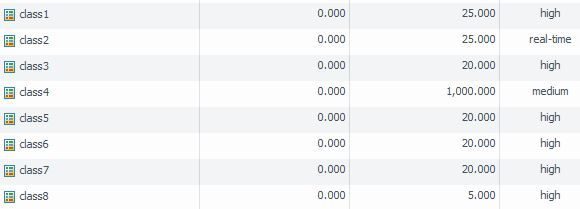- Access exclusive content
- Connect with peers
- Share your expertise
- Find support resources
Click Preferences to customize your cookie settings.
Unlock your full community experience!
Qos profile
- LIVEcommunity
- Discussions
- General Topics
- Re: Qos profile
- Subscribe to RSS Feed
- Mark Topic as New
- Mark Topic as Read
- Float this Topic for Current User
- Printer Friendly Page
- Mark as New
- Subscribe to RSS Feed
- Permalink
03-28-2017 11:57 AM
@sib2017 The priority is listed in the far right column. Class 2 traffic being real-time will be given the highest priority and everything but class4 is being assigned high priority. Keep in mind that everything by default is class4 on the PA., you need to enable QoS on the interface level, and it looks like whoever setup the Maximum egress didn't really care about anything but the default class4 traffic.
I would look at some of the QoS articles on live; most of them do a really good job of explaining things but setting up QoS on the PA can be seen as weird from someone used to primarly working with switches and routers.
- Mark as New
- Subscribe to RSS Feed
- Permalink
03-28-2017 06:51 PM
Hi,
Thank you for the reply , I am using class 2 for skype and skype probe , the issue is sometimes the audio is lagging than video
Thanks
- Mark as New
- Subscribe to RSS Feed
- Permalink
03-28-2017 07:37 PM
Hi,
Is it necessary to mark qos in the switch level ( from the access layer or distribution layer ), if we are enabling qos on PA ?.
pa will mark qos on the packet if we are sennding to the upstream router ?
Thanks
- Mark as New
- Subscribe to RSS Feed
- Permalink
03-29-2017 12:17 AM
Hi @sib2017
the PANW QoS is going to apply limits/make reservations and prioritize sessions on the system but will not mark packets
marking is supported on the security policies, but then an external device becomes responsible for enforcing QoS:

if you want to prevent the audio/video from lagging, it may also be a good idea to set a reservation for bandwidth, so you don't run out.
even with the priority set to realtime (which will assign top priority queueing in a dedicated queue) there may still be a bandwidth issue preventing you from achieving lossless audio/video
PANgurus - Strata specialist; config reviews, policy optimization
- Mark as New
- Subscribe to RSS Feed
- Permalink
03-29-2017 01:10 AM
Hi reaper ,
Usually the enforcing device must be the upstream device ( router or firewall ) ? .
I have deployed pa in vw mode. my upstream device is asa fw and then router
Thanks
- Mark as New
- Subscribe to RSS Feed
- Permalink
03-29-2017 01:17 AM
if you use the 'QoS marking' option, then yes, an upstream device needs to do the shaping
if you configure QoS on the PANW, it will apply shaping just fine and you wont need external devices
PANgurus - Strata specialist; config reviews, policy optimization
- Mark as New
- Subscribe to RSS Feed
- Permalink
03-29-2017 02:01 AM
Hi,
If we configure the qos on PANOS and the packet reached on upstream asa or router , How the asa will treat this packet if there is no qos related service enabled ( policy )
Thanks
- Mark as New
- Subscribe to RSS Feed
- Permalink
03-29-2017 02:45 AM
sensing much confusion, I am
😉
ok ok lemme start fresh
1) there are QoS policies and QoS profiled on the panw firewall which allow you to set maximum throughput or guaranteed throughput for certain classes of traffic. you can also set a priority which, in case the firewall is starved for resources (high DP load) can prioritize the IO of certain sessions. all this is achieved on the firewall without the outside being aware something is being limited or prioritized
2) QoS marking through a security policy: the firewall adds a QoS 'color' to the packets in a session (DSCP codepoint, like a flag in tcp header) so external devices can pick up on these colored packets (upstream loadbalancers or other firewalls/routers) and prioritize/deprioritize based on the 'color' of the packet, IF they understand DSCP codepoints
PANgurus - Strata specialist; config reviews, policy optimization
- Mark as New
- Subscribe to RSS Feed
- Permalink
03-29-2017 06:25 AM - edited 03-29-2017 06:29 AM
@sib2017 if you're putting the time and effort to do QOS mappings on your ASA and PA then you really should enable it on the access layer. When setting up QOS you pretty much want to have it on the full stream if possible, but usually most people would do QOS on the access and distribution layer and then would have the firewall scaled to the point they don't have to worry about doing QOS on it as much, as most ISPs won't listen to DSCP codepoints.
I would really recommend that you work on creating QOS statements on your access layer before you worry to much about working with QOS on your firewall unless your dataplane is constantly starved for resources. It is far more likely that the access or distribution layer is dropping packets in the queue than your firewall dropping them, unless of course your ASA or PA is not scaled for your network properly.
Also yes if you have the PA set to do DSCP codepoints you also need to tell your ASA what to do with them so that it prioritizes things properly. It's important to note that QOS simply tells the device how it should be processing the traffic; so if the traffic can all be processed almost instantly and not build up in the queue then you really never take advantage of your QOS statements, but if the queue starts to fill up then the device uses the QOS statements to know what you want to prioritize and actually process first, second, third, and so on.
- Mark as New
- Subscribe to RSS Feed
- Permalink
03-29-2017 10:33 AM
Hi,
" would really recommend that you work on creating QOS statements on your access layer before you worry to much about working with QOS on your firewall unless your dataplane is constantly starved for resources."
Is it ok setting qos for skype through gpo on end user's pc
http://blogs.perficient.com/microsoft/2014/12/configuring-quality-of-service-for-lync-online/
or is it must we need to do on access switches or in distribution switches
Thanks
- Mark as New
- Subscribe to RSS Feed
- Permalink
03-29-2017 10:44 AM
Hi,
Did you verify how much class 2 traffic goes through your firewall when you test Skype? Does it constantly cap at 25 Mbps? You can see the real-time statistics under the Network tab, then QoS and click on Statistics for the desired interface.
Benjamin
- Mark as New
- Subscribe to RSS Feed
- Permalink
03-29-2017 11:35 AM
@sib2017 end-user qos is usually done more so for simplified QOS markings; basically so that you know what DSCP value will come across so that you can quickly build the QOS statements on your switches. Once the traffic is tagged with DSCP 46 you still need to tell the switch how to actually process the DSCP 46 traffic and what priority it should actually get that traffic out of the outbound/inbound queue.
It sounds like what you should do is
1) Build the GPO so that you know what DSCP value is going to be marked
2) Build out the qos statements on your switches (no idea what brand you are using for this, I could provide a Cisco example if that is what you are using). Depending on the brand it may default to standard QOS statements, but likely qos isn't enabled out of the box.
3) If it's still choppy then start looking at QOS on the PA; likely though you are running into issues before you reach the firewall.
- Mark as New
- Subscribe to RSS Feed
- Permalink
03-29-2017 10:17 PM
Hi,
yes I am using cisco 3850 at access layer
Thanks
- 5922 Views
- 13 replies
- 0 Likes
Show your appreciation!
Click Accept as Solution to acknowledge that the answer to your question has been provided.
The button appears next to the replies on topics you’ve started. The member who gave the solution and all future visitors to this topic will appreciate it!
These simple actions take just seconds of your time, but go a long way in showing appreciation for community members and the LIVEcommunity as a whole!
The LIVEcommunity thanks you for your participation!
- Need clarification on URL Filtering logs in Next-Generation Firewall Discussions
- Panorama REST API policy creation error with ' 'message': 'Invalid Body', in Panorama Discussions
- TID 95187 is not on my signature list in Threat & Vulnerability Discussions
- GP Portal logs showing local password guessing attempts even though I'm using Azure IdP. Should I be concerned? in GlobalProtect Discussions
- PA3260 HA secondary SNMP credential not working in Next-Generation Firewall Discussions




